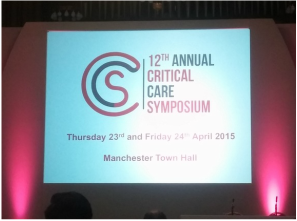
The Critical Care Symposium
Sepsis
There’s other stuff on the horizon besides this excitement though. The news of a ‘biospleen’ was a bit out of the blue and intriguing for myself. Though still at the animal model stage, this is trying to be the blood filter for all that nastiness we were talking about in sepsis. Still a sounds a bit too sci-fi for me at the moment but you never know, this might be the dialysis of sepsis in a few years time.
The themes of biomarkers and prognostication were both recurring themes over the two days. As mentioned above, talk is increasingly of the body’s maladaptive response to infection in sepsis and the balance of a hyper-inflammatory immune response vs immunosuppression. With this understanding we are in urgent need of good biomarkers to tell us what is going on (the creatinine of the immune system as it was nicely described) and to help identify pathogens earlier (negative blood cultures 48 hours later anyone?). The talk of the transfer of PCR technology to the bedside did genuinely get me rather excited. Though they once again sound a little way off making their way into clinical practice, the idea of putting a blood sample in a machine and just a few hours later getting the guilty pathogen back (or a list of a few) was a pretty cool idea. I think the days of the faithful blood culture bottle (and its false positive contaminants) are numbered, but again we're still a way off.
The Surviving Sepsis Campaign
The Biospleen - Nature
Sepsis 3.0: Sepsis = infection + badness #12thCCS
— Thomas Heaton (@tomheaton88) April 24, 2015
Exciting prospects for the future of sepsis biomarkers. Hopefully at least some will fulfill this promise #12thCCS pic.twitter.com/q3WlFFuucS
— Thomas Heaton (@tomheaton88) April 23, 2015
ARDS
So after all this talk of exciting stuff, the reality seemed to be that we are still in a situation where we need to get the basics right. I think it was Prof Gattinoni who delivered a great overview of the postulated mechanisms ARDS development and for avoiding injurious ventilation by minimising energy transfer to the lung. The vicious circle of collapsed lung units and increasing ventilation pressures leads to increased energy transmission to no collapsed units and more damage. As such, it’s about doing the basic things right (protective ventilation, fluid restriction) and escalating as needed (prone, higher PEEP, paralysing agents) and hope this is enough to let the whole process calm down. Until we get some magic drugs it looks like this will be our best bet.
The Berlin Definition
The BALTI-2 Trial
Mesenchymal Stem Cell Therapy
Lung protection = less energy + more homogenous lung pic.twitter.com/K1yB5aBRK9
— Thomas Heaton (@tomheaton88) April 24, 2015
Summary: energy transfer to lung causes badness, collapsed lung puts strain on surrounding lung, recruitment and PEEP protective #12thCCS
— Thomas Heaton (@tomheaton88) April 24, 2015
And The Rest...
There were some interesting talks on the neurological challenges we face with Bill Coplin giving a great talk on some of the recent updates. The MR CLEAN trial sounded very interesting, suggesting an improvement if we treat ischaemic stroke with aggressive intra-arterial reperfusion strategies rather than systemic thrombolysis, perhaps a bit more like with myocardial infarctions. The REVASCAT trial was also promising, suggesting that the unopposed destruction that ischaemic stroke has wrought may be being increasingly challenged. For a pathology that has such crippling consequences this really is great news. He also talked a bit about the dogma that a GCS of 8 or lower mandates intubation. Where did this all come from? He argues it’s primarily from the massive increase in mortality with even a single episode of hypoxia, and thus a need to keep a patent and protected airway to avoid this. It’s unlikely that GCS 8 is the clear line where this transition of airway control occurs, but thinking about where these concepts come from is as important as knowing what to do.
MR CLEAN Trial
REVASCAT Trial
Revascat trial: 1.7 reduction in disability from ischaemic stroke. Clot retrieval in stroke the future? #12thCCS
— Thomas Heaton (@tomheaton88) April 24, 2015
Until Next Year
Tom Heaton
 RSS Feed
RSS Feed
